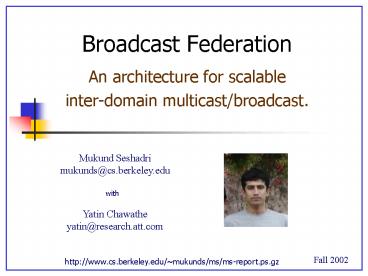Broadcast Federation - PowerPoint PPT Presentation
1 / 9
Title:
Broadcast Federation
Description:
Commodity hardware. Easier customizability and deployability. Inefficient hardware. Source ... TRANSLATION messages contain IP addresses of data nodes in the cluster. ... – PowerPoint PPT presentation
Number of Views:22
Avg rating:3.0/5.0
Title: Broadcast Federation
1
Broadcast Federation
- An architecture for scalable
- inter-domain multicast/broadcast.
Mukund Seshadri mukunds_at_cs.berkeley.edu
with
Yatin Chawathe yatin_at_research.att.com
Fall 2002
http//www.cs.berkeley.edu/mukunds/ms/ms-report.p
s.gz
2
Motivation
Goal
- Design an architecture for the composition of
different, non-interoperable multicast/broadcast
domains to provide an end-to-end one-to-many
packet delivery service. - Design and implement a high performance
(clustered) broadcast gateway for the above
architecture
- No universally deployed multicast protocol.
- e.g. IP Multicast, SSM, Overlays, CDNs
- Typical problems
- Address-space scarcity (in IP Multicast)
- Limited scalability
- e.g. IP Multicast involves some form of flooding
- Need for administrative boundaries.
3
Architecture
Source
- Broadcast Network (BN) any multicast capable
network/domain/CDN) - Broadcast Gateway (BG)
- Bridges between 2 BNs
- Explicit BG peering
- Overlay of BGs
- Analogous to BGP routers.
- App-level
- For both app-layer and IP-layer protocols
- Less efficient link usage, and more delay
- Commodity hardware
- Easier customizability and deployability
- Inefficient hardware
Clients
BG
BN
Peering
Data
4
Naming
- A session is associated with a unique Owner BN
- For shared tree protocols
- Address space limited only by individual BNs
naming protocols. - URL style- bin//Owner_BN/native_session_name/flow
_1_name/flow_2_name/?pmtr1value1... - native_session_name - specific to the owner BN
- flow(s) related flows grouped under 1 session.
- pmtr(s) metrics, transport, single-source/multi-
source.
Routing
- Path vector algorithm to propagate BN/BG
reachability info - Scope for forwarding policy hooks
- Different routes for different metrics/options
- e.g. BN-hop-count best-effortmulti-source,
latencyreliable, etc. - Session-agnostic, in order to avoid all BNs
knowing about all sessions.
5
Distribution Trees
- One reverse shortest path-tree per session
- Tree rooted at owner BN.
- Soft BG tree state(Session Upstream node
list of downstream nodes) - Bi-directional.
- Fine-grained selectivity using SROUTE messages
before JOIN phase. - Built using JOIN messages, like PIM-SM.
B-Fed Mediator (an abstraction)
- Client in owner BN ? no interaction with the
federation. - Client not in owner BN ? needs to send JOIN to a
BG in its BN - So, BNs are required to implement the Mediator
abstraction, for sending JOINs for sessions to
BGs. - e.g. a mediator IP multicast group
- e.g. routers or other BN-specific aggregators
6
Data Forwarding
- Decouples control from data
- i.e. control nodes from data nodes.
- TRANSLATION messages carry data path addresses
per session - e.g. TCP/UDP/IP Multicast addressport.
- e.g. a transit SSM network might require 2
channels to be setup for one session.
NativeCast (interface)
- Encapsulates all BN-specific customization
- Interface to local broadcast capability
- Send and Receive broadcast data
- Allocate and reclaim local broadcast addresses
- Subscribe to and unsubscribe from local broadcast
sessions - Implement Mediator functionality intercept
and reply to local JOINs - Get SROUTE values.
7
Clustered BG design
- 1 Control noden Data nodes.
- Control node ?routing tree-building.
- Independent data paths ? flow directly through
data nodes. - TRANSLATION messages contain IP addresses of data
nodes in the cluster. - Throughput bottlenecked only by the IP
router/NIC. - Soft data-forwarding state at data nodes.
8
Implementation
- Linux/C event-driven program
- NativeCast for IP Multicast, simple HTTP-based
CDN and SSM 700 lines of code each. - Setup
- No. of sources no. of sinks no. of Dnodes.
(so that sources/sinks dont become bottleneck). - Each machine capable of driving a 350Mbps
throughput TCP stream. - 500MHz PIIIs 1 Gbps NICs.
Note maximum (TCP-based) throughput achievable
using different data message (framing) sizes is
shown above.
Variation of 1-Dnode throughput when no.
of sessions is increased to several sessions is
shown. The sources are rate-unlimited.
9
Summary
- 1 Gbps B/W with 5 Dnodes
- 2500 sessions with 5 Dnodes
- Throughput reduces with high number of sessions
- Higher framing sizes yield higher throughput.
Variation of 1-Dnode throughput when the frame
size is varied is shown. The sources are
rate-unlimited.
Future Work
- Use better I/O interfaces for higher throughput
with large number of file descriptors (kernel
patch or OS change required). - What if a client has access to multiple BNs?
- Wide area deployment?































